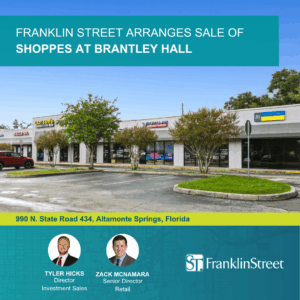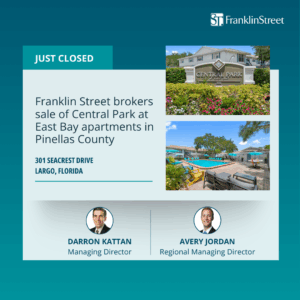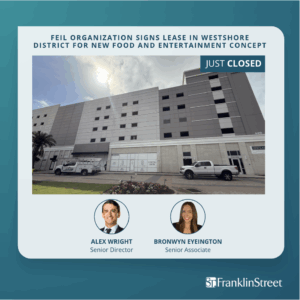MIAMI—Retail leasing is hot in Miami, but how does it pan out in other parts of the state? We caught up with Carrie Smith, regional managing partner with Franklin Street’s Jacksonville office, to get her take on the pulse of retail leasing. In part one of this exclusive interview, she shares the trends she’s seeing and the factors that influence her strategy.
GlobeSt.com: What is the state of retail leasing and how has it changed over the past 12 months?
Smith: We’re seeing a higher transaction volume this year compared to last, and in discussions with our clients and colleagues this trend is consistent across the southeast. We’re also noticing that franchise-driven concepts are signing up franchisees at a pace that is hard to keep up and the corporately driven concepts are expanding again.
Also important to point out is new construction has started up again, albeit not at the rate we saw prerecession, but we’re certainly seeing new developments come out of the ground. We’re also seeing that the value-based brands continue to expand, as well as fast casual restaurants, which have been very aggressive with growth these past 12 months.
GlobeSt.com: Is it easier or more difficult to get retail leases done? How creative do you have to get these days?
Smith: Compared to a year ago, the ease of handling retail leases has remained unchanged. However, compared to five years ago it is much more difficult. Both landlords and tenants were hurt by the recession, but in different ways that are now reflected in any lease negotiation.
For example, many owners will refuse to offer reduced rents to small shop tenants, should an anchor go dark. On the other hand, retailers want to have options in the event the anchor store exits their center and are requiring some sort of reduced rent or option to terminate. Finding the middle ground is key to these types of situations by having a clear understanding up front of what both sides need to achieve in any deal point.
GlobeSt.com: What trends are you seeing in retail leasing? For example, are certain product types hotter than others? Certain sizes trending generally? Tenants looking for particular features? Is it a tenant’s market or a landlord’s market?
Smith: We’re still seeing the value-oriented brands expand this year, including the dollar stores, the value-based hair salons, such as Great Clips, and discounted fitness centers. Fast casual restaurants might not have replaced sit-down restaurants, but they have definitely made a place in our society as families look for quicker and cheaper options for a meal out.
2013 saw the expansion of boutique, specialized grocers like Trader Joes and Earthfare. I think in 2014 we’ll see even more of these open as we know deals are currently being worked and signed.
Another interesting trend is the medical/office user taking up space in traditional retail centers. If you look at any shopping center today, you’re bound to see an urgent care, primary care, or specialty care tenant. The availability of parking is a huge draw for these tenants and they tend to backfill spaces with limited visibility that traditional retailers avoid.
As opposed to a tenant or a landlord market, I believe we’ve found ourselves in more of a “fair” market. Retailers can still find good locations with solid terms, but landlords are pulling back with regard to what they are willing to offer in today’s environment.
GlobeSt.com: Is there a one-size fits all strategy for handling retail real estate leasing transactions or does the strategy vary widely based on the market and the landlord and the tenant? What factors influence your strategy?
Smith: There is no one size fits all strategy when it comes to handling retail leasing transactions … I wish there was! Rather, it varies widely based upon the trade area and the type of client you’re working with in the transaction. The most influential factor in a transaction typically comes down to the success of the area or shopping center. Class A space is virtually unavailable and if something should become available, a tenant will need to be aggressive to get into that space. Download PDF



